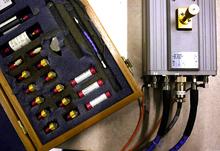Summary
NIST CTL’s Radio Frequency Technology Division conducts research into electromagnetic measurement, modeling, and theory in support of advanced wireless communications. Our work is concentrated on measuring quantifiable properties of microwave electronics, the properties of integrated circuit materials, and advanced integrated-circuit testing. This research is fundamental to confronting next-generation engineering challenges like shared spectrum management, device-to-device communication and the Internet of Things, enabling a world where diverse wireless devices and systems can coexist without compromise.
Description
Engineers designing the next generation of wireless applications and devices must work around the fundamental issue of radio interference. NIST CTL’s RF Technology High Speed Electronics group focuses on fundamental measurement and modeling of nonlinear microwave systems, devices and materials that is critical to addressing this challenge. Major research thrusts are Traceable Microwave Power, Traceable Impedance,On-chip Materials and Advanced IC Metrology.

TRACEABLE MICROWAVE POWER AND IMPEDANCE
Traceable measurements of microwave power are the basis of current and future wireless hardware. Particularly relevant to the wireless industry are modulated signal measurements and accurate evaluation of systems, components and devices. The industry also requires a trusted determination of impedance of a reference environment, which can in turn be used in linear transformations to target reference planes. NIST CTL provides these fundamentals and works to disseminate measurement data, analysis techniques and modeling to the communications community.
ON-CHIP MATERIALS
A complete understanding of the materials utilized in the electronic components that make up telecom equipment is crucial for the wireless communications industry. Knowing the performance of a component’s material is fundamental to building larger and more complex communications systems. Since the accuracy of component modeling depends on the accuracy of the input material parameters, we focus on the accurate measurement of high frequency material properties beyond linear, isotropic and homogeneous limits. The result is interference reduction, lower power consumption, and higher spectral efficiency and integration in wireless communications. We accomplish this primarily through detailed comparisons of computational models with broadband measurements of custom-built planar test structures.
ADVANCED IC METROLOGY
The electronic components used in communications systems must control electrical signals at multiples of the device’s specified operating frequency. Designers of these systems need test equipment that can generate signals with precisely known and controlled magnitudes and phases, and at the harmonics required for the next generation of high-frequency equipment. In response to this challenge our large amplitude optoelectronic multitone electrical-signal synthesizer will facilitate tests on communications devices operating above 40 GHz. These tests make possible high-bandwidth, low-latency wireless services that will drive autonomous vehicles, augmented reality and exascale computing and many other wireless dependent devices and services.

